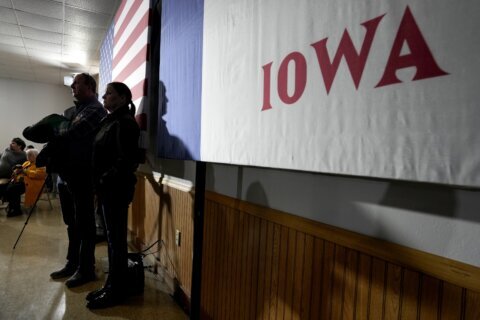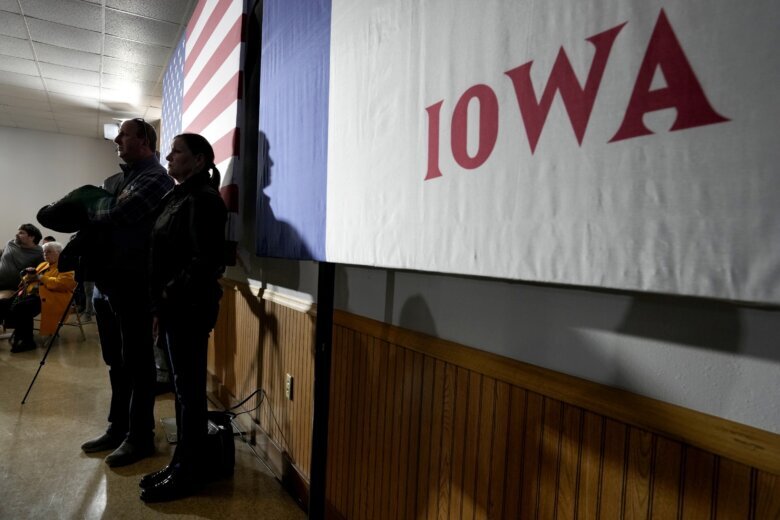
WASHINGTON (AP) — The race for the White House officially begins in less than two weeks, and despite some prolonged jockeying over the election calendar, the long primary season will once again begin in Iowa with a caucus process that has served as the lead-off voting event since the 1970s.
While Iowa has played an outsize role in presidential politics for generations, the details of how the caucuses actually work can surprise and mystify even hard-core political junkies. The Republican process this year is largely unchanged, but there are significant changes to the traditional voting schedule on the Democratic side. Much of what you think you know about the Iowa caucuses may no longer be applicable in 2024.
Since the contested Iowa caucuses of 2016 and 2020 may seem like a long time ago, here’s an update of what they are, how they work and why they matter.
What is a caucus?
A political caucus is a gathering of people with a shared interest or goal. The Iowa caucuses are a series of local meetings held throughout the state where participants conduct party business and usually indicate their preference for a presidential nominee to represent the party on the November ballot. It’s also the first step in a months-long process to select people to serve as delegates to the national party conventions this summer.
How are caucuses different from primaries?
One of the main differences between caucuses and primaries is the amount of time allotted for voting to occur and the methods by which people can vote. In a primary, people can show up at the polls and cast ballots throughout Election Day, from the early morning until polls close in the evening. They have the option of casting an absentee ballot if they can’t make it to the polls on Election Day, and in some states, people may vote before Election Day. The Iowa caucuses, on the other hand, are held in the evening and voters must attend in person in order to participate, except in a few isolated instances. Caucuses are run by political parties, whereas primaries are usually (but not always) run by the state.
Are both the Republicans and Democrats holding caucuses in Iowa this year?
Sort of. While both the state Republican and Democratic parties will hold caucuses on Jan. 15, only the Republican event will have an immediate, binding impact on the presidential race. In a departure from previous years, the Democratic caucuses will be held only to conduct administrative party business and to start the process of choosing delegates to the national conventions. Iowa Democrats will express their preferences for their party’s presidential nominee through a mail-in voting process, the results of which will not be known until March.
What’s at stake?
For Democrats, nothing is at stake, since the 2024 caucuses will have no bearing on the presidential race.
For Republicans, there are usually two prizes in the Iowa caucuses: delegates and bragging rights. Iowa Republican voters will indicate their picks for the party’s presidential nominee, and the results of that vote will determine how many of the state’s 40 convention delegates each candidate will receive. Candidates win national convention delegates in direct proportion to the percentage of the vote they receive. There is no minimum threshold required to qualify for delegates.
However, Iowa makes up a minuscule share of the total number of Republican delegates nationwide (only 1.6%). So, in theory, a candidate who performs poorly in Iowa has plenty of opportunities in the remaining states and territories to more than make up the difference. But because of Iowa’s first-in-the-nation placement in the presidential campaign calendar, the caucus results often give a disproportionate boost to the winners and to those who perform strongly or surpass expectations, while often having a winnowing effect on the field by nudging underperforming candidates out of the race. They can also signal to voters in other states, fairly or unfairly, which candidates are possibly on a better footing in the race for the nomination and have momentum (or the “Big Mo” as candidate George H.W. Bush called it after winning the 1980 caucuses) heading into the next contests.
How will the Republican caucuses work in 2024?
There will be two main agenda items at every Republican caucus site: holding a binding vote for the party’s presidential nominee and electing delegates to attend county conventions, which is the next step in the multi-tiered process of electing delegates to attend the Republican National Convention in Milwaukee this summer.
The binding presidential vote functions essentially like a party-run primary, only with very limited polling hours and no accommodation for absentee voting, except for a tiny handful of overseas and military voters. There are speeches on behalf of various candidates before the voting and a variety of party business after the vote. Individual caucus chairs are allowed to exercise some discretion in how to conduct the vote, but the voting is done by secret ballot and there is no set list of candidates. Voters must be given the option to vote for any candidate they choose. In the past, some caucus sites have pre-printed the names of major candidates and provided a write-in option, but typically, voters vote by writing the name of a candidate on a blank slip of paper.
There is no walking around the caucus room to form candidate preference groups. That voting method was a feature of Democratic caucuses from 1972 to 2020 but is no longer in use by either party in 2024.
The Republican caucuses will convene statewide at 7 p.m. local time (8 p.m. EST), and begin with the election of a caucus chair and secretary. Only registered Republicans may participate in the caucuses and only in their designated home precincts. However, Iowans may register or change their party affiliation on caucus day. Voters must turn 18 by the November general election in order to participate.
How will the Democratic caucuses work in 2024?
Iowa Democrats had to completely redo their caucus and presidential delegate selection process after their 2020 caucuses devolved into chaos and failed to produce a clear, undisputed winner.
This year, Iowa Democrats will still hold caucuses on the same day as Republicans, but unlike in previous years, caucus-goers will not vote or indicate their pick to represent the party on the November presidential ballot. Instead, they will vote for a party nominee through a mail-in voting process that begins Jan. 12 and concludes on March 5.
The Democratic caucuses on Jan. 15 will elect delegates to the county conventions in March, which is the next step in selecting the individuals to serve as delegates to the Democratic National Convention in Chicago in August. National convention delegates will be required to vote for a presidential nominee in accordance with the results of the mail-in voting process.
___
This story has been corrected to reflect that the Democratic caucuses in 2020, not 2024, devolved into chaos.
Copyright © 2025 The Associated Press. All rights reserved. This material may not be published, broadcast, written or redistributed.








